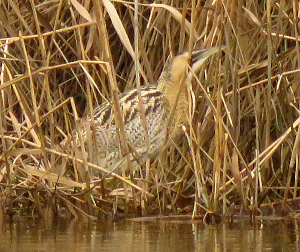Migrant Hawker trapped in a spider's web
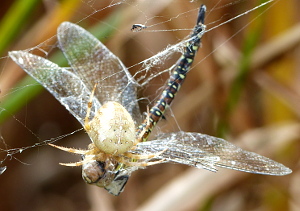 There were numerous Migrant Hawkers Aeshna mixta at Pickering Park Lake on 14th September. Each sizeable clump of rushes around the edge of the lake had 2-5 males patrolling through the vegetation. Only a few female Migrant Hawkers were spotted including a female which was egg laying in the rushes. One unfortunate female, when flying though the rushes, had become trapped in the web of a Garden Spider Araneus diadematus. This Migrant Hawker was already lifeless when we found it.
There were numerous Migrant Hawkers Aeshna mixta at Pickering Park Lake on 14th September. Each sizeable clump of rushes around the edge of the lake had 2-5 males patrolling through the vegetation. Only a few female Migrant Hawkers were spotted including a female which was egg laying in the rushes. One unfortunate female, when flying though the rushes, had become trapped in the web of a Garden Spider Araneus diadematus. This Migrant Hawker was already lifeless when we found it.
Dick Shillaker, 23 September
Essex Skipper - St Andrew's Quay
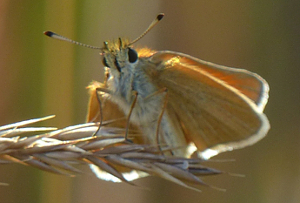
Picture Andrew Ashworth, 16 July
Hull Nats and the New Year Plant Hunt
The BSBI's 2019 New Year Plant Hunt which ran from 29th December 2018 to 1st January 2019 was once again well-supported by Hull Nats. Six people turned out on 30th December for a Beverley walk and eight combed Hornsea on New Year's day. Both were new locations for the plant hunt. Our aim was to find as many wild and naturalised plants in flower as we could within 3 hours.
Having spent the summer on a botanical survey of Beverley we had little trouble finding a suitable route for Sunday's walk, which took in the waste ground and industrial area at Grovehill, the river, the beck and Grovehill Road. Beverley is so compact we had no need to go far to find 70 species actually in flower.
Star finds -
Greater Burnet-saxifrage on the lane leading to Jacob’s Well;
Common Whitlowgrass*, White Melilot, Hazel catkins* on the waste ground itself; Lesser Celandine* and Common Stork's-bill in the industrial area;
Snowdrop*, Pellitory-of-the-wall and Water Figwort by Beverley beck;
Grasses with exserted anthers: Italian Rye-grass, Wild-oat, Water Bent and Cock's-foot.
It was easy, leisurely and highly enjoyable. A long period of mild weather in December and the sheltered situation probably account for the fact that we took our place on the NYPH leader board, initially placed second, behind a Rare Plants group.
Hornsea was a tougher proposition. Distances were greater. Time was short. Lesley took her duties as host seriously and largely succeeded in keeping us together on a lengthy dash taking in a cemetery, the front, a churchyard, road verges, mere side, old railway line, drain and open allotments… and we mustered a heroic 60 species. Fun, energetic, exhilirating.
Star finds - Sea Mayweed near the front; Small Melilot on a verge; Winter Aconite*, Snowdrop* and Polyanthus in a cemetery; Creeping Comfrey at the back of the churchyard.
Admissible grasses: Annual Meadow-grass, Cock's-foot, Water Bent and Wall Barley.
*Spring flowers blooming early in the mild weather
Irrelevant to our task but noteworthy was John's discovery of Hard Shield-fern by the railway line, a first record for Hornsea.
We returned to find the big hitters from the south coast and Wales well ahead with scores of 120 at Swanage and 118 at Cardiff Bay. Surprisingly, our Hornsea list initially made longest lists board at 17th, before sinking, but our Beverley list finished in 13th place. Statistics: in 2019 during the Plant Hunt 702 lists were sent in, 640 species were recorded and 14 232 unique records made. We found all 20 of the most frequent plants excepting Gorse. As last year Daisy topped the lists.
Thanks to all those who took part. Particular thanks to Lesley, our Hornsea host, and to Helen for sticking with the phone app. Our observations each year provide data for phenological studies. Not just for fun then!
Gabrielle Jarvis, 7 January
Gorse - the one that got away ...
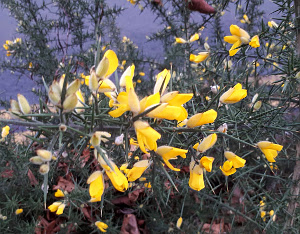 BSBI New Year Plant Hunt - Gorse was the only plant on top 20 list we failed to find on both occasions.
BSBI New Year Plant Hunt - Gorse was the only plant on top 20 list we failed to find on both occasions.
Picture A Gómez
 There were numerous Migrant Hawkers Aeshna mixta at Pickering Park Lake on 14th September. Each sizeable clump of rushes around the edge of the lake had 2-5 males patrolling through the vegetation. Only a few female Migrant Hawkers were spotted including a female which was egg laying in the rushes. One unfortunate female, when flying though the rushes, had become trapped in the web of a Garden Spider Araneus diadematus. This Migrant Hawker was already lifeless when we found it.
There were numerous Migrant Hawkers Aeshna mixta at Pickering Park Lake on 14th September. Each sizeable clump of rushes around the edge of the lake had 2-5 males patrolling through the vegetation. Only a few female Migrant Hawkers were spotted including a female which was egg laying in the rushes. One unfortunate female, when flying though the rushes, had become trapped in the web of a Garden Spider Araneus diadematus. This Migrant Hawker was already lifeless when we found it.



 BSBI New Year Plant Hunt - Gorse was the only plant on top 20 list we failed to find on both occasions.
BSBI New Year Plant Hunt - Gorse was the only plant on top 20 list we failed to find on both occasions.
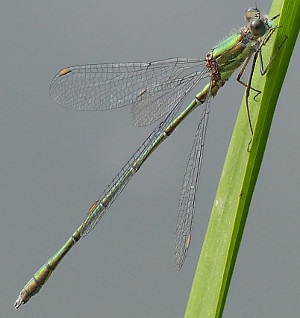 This male Willow Emerald Damselfly Chalcolestes viridis was photographed in East Park, Hull on Sunday 8th September; it is apparently the first verified record of the species in south east Yorkshire and possibly only the second record for the whole county. The finding was not unexpected as the Willow Emerald (commonly found in central and southern Europe) has been spreading northwards with reports this year from Cleethorpes and Alkborough, and with one record from just north of Scarborough. At East Park, I spotted some differences from our 'local' Emerald Damselfly Lestes sponsa, notably the small pale brown 'cell', pterostigma, on each wing. However, I could not get a clear enough view of the insect and, being such a recent colonist of the UK (first adult reported from Suffolk in 2007), this species was not featured in the field guide I had with me. Closer examination of photographs on the computer revealed clear features of Willow Emerald such as the forward pointing dark spur on the side of the thorax. I would expect more records from East Park as the lake would seem to provide ideal habitat for a species that lays its eggs in branches of trees, especially willows, overhanging water.
This male Willow Emerald Damselfly Chalcolestes viridis was photographed in East Park, Hull on Sunday 8th September; it is apparently the first verified record of the species in south east Yorkshire and possibly only the second record for the whole county. The finding was not unexpected as the Willow Emerald (commonly found in central and southern Europe) has been spreading northwards with reports this year from Cleethorpes and Alkborough, and with one record from just north of Scarborough. At East Park, I spotted some differences from our 'local' Emerald Damselfly Lestes sponsa, notably the small pale brown 'cell', pterostigma, on each wing. However, I could not get a clear enough view of the insect and, being such a recent colonist of the UK (first adult reported from Suffolk in 2007), this species was not featured in the field guide I had with me. Closer examination of photographs on the computer revealed clear features of Willow Emerald such as the forward pointing dark spur on the side of the thorax. I would expect more records from East Park as the lake would seem to provide ideal habitat for a species that lays its eggs in branches of trees, especially willows, overhanging water.
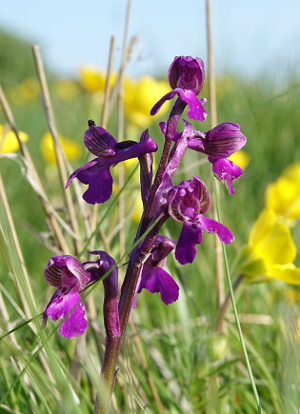 On 13 May Mervin Nethercoat of the Beverley Naturalists' Society discovered a single flowering spike of Anacamptis morio growing on Beverley Westwood. In the 19th century this orchid was considered to be very common in pastures throughout East Yorkshire; it is now restricted to only a (small) handful of sites. A very welcome new record!
On 13 May Mervin Nethercoat of the Beverley Naturalists' Society discovered a single flowering spike of Anacamptis morio growing on Beverley Westwood. In the 19th century this orchid was considered to be very common in pastures throughout East Yorkshire; it is now restricted to only a (small) handful of sites. A very welcome new record!
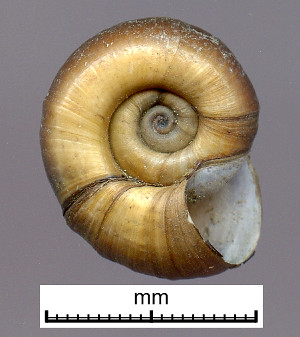 A shell of Planorbarius corneus found in dredgings from the Barmston Drain near Arram. The specimen was imaged using a desk-top scanner.
A shell of Planorbarius corneus found in dredgings from the Barmston Drain near Arram. The specimen was imaged using a desk-top scanner.
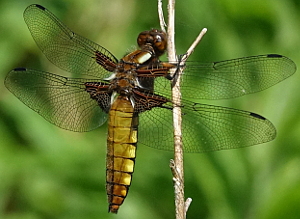
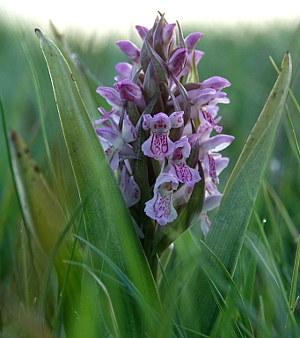 Our evening visit to Swine Moor was rewarded with the discovery of two flowering spikes of Dactylorhiza incarnata subsp. incarnata discovered independently by Gabrielle Jarvis and Helen Kitson. This is a very scarce plant in East Yorkshire and appears to be the first Beverley record since it was noted by Robert Teesdale in 1800.
Our evening visit to Swine Moor was rewarded with the discovery of two flowering spikes of Dactylorhiza incarnata subsp. incarnata discovered independently by Gabrielle Jarvis and Helen Kitson. This is a very scarce plant in East Yorkshire and appears to be the first Beverley record since it was noted by Robert Teesdale in 1800.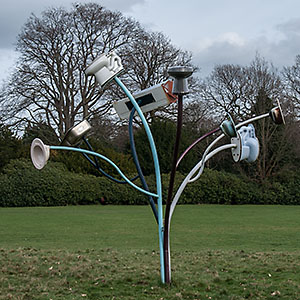 Highlight of the field trip to the Yorkshire Sculpture Park was this Sanitary-ware tree (Lavatera latrinis). Found only within the boundaries of the park, it favours wetter areas close to drains and sewers. It is dioecious, the two sexes being distinguished by examining the ‘seats’ which are more frequently in the raised position in the male. The large flowers are pollinated by flies, attracted by the characteristic scent, which is particularly noticeable in warm weather.
Highlight of the field trip to the Yorkshire Sculpture Park was this Sanitary-ware tree (Lavatera latrinis). Found only within the boundaries of the park, it favours wetter areas close to drains and sewers. It is dioecious, the two sexes being distinguished by examining the ‘seats’ which are more frequently in the raised position in the male. The large flowers are pollinated by flies, attracted by the characteristic scent, which is particularly noticeable in warm weather.
